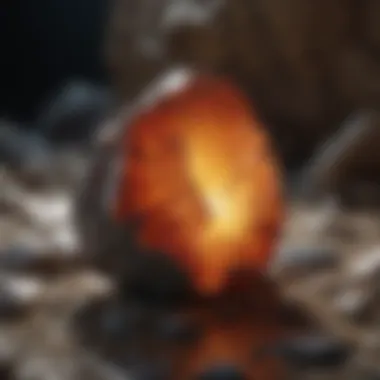Unveiling the Enigmatic Black Flashlights: A Guide for Rock and Fossil Enthusiasts


Rock and Fossil Identification
Diving into the world of rock and fossil identification unveils a fascinating realm of discovery for enthusiasts in the field. Rocks span a diverse array of types, from sedimentary to igneous and metamorphic, each showcasing distinct characteristics formed through geologic processes over millennia. Fossils, on the other hand, offer a glimpse into ancient life forms preserved in stone, providing valuable insights into Earth's history. To identify these geological treasures, collectors keenly observe key features such as color, texture, hardness, and any unique imprints or structures. Utilizing specialized tools such as magnifying lenses, hardness picks, and UV lights aids in comprehensive examination and classification.
Collecting Tips and Techniques
For rock and fossil collectors, honing collecting skills is crucial to ensure successful ventures into the field. Implementing best practices such as thorough research on prime collecting sites and local geology enhances the likelihood of discovering rare specimens. Knowledge of safe extraction techniques minimizes damage to fragile specimens and preserves their integrity for further study. Successful collectors utilize hammers, chisels, gloves, and protective eyewear to extract specimens carefully without causing harm to themselves or the surrounding environment.
Preservation and Display
Preserving and displaying collected rocks and fossils requires a delicate balance between protection and showcasing their beauty. Techniques like cleaning with gentle brushes, stabilizing fragile specimens, and using archival-quality storage materials ensure longevity. Proper storage methods involve storing specimens away from direct sunlight, extreme temperatures, and moisture to prevent degradation. Creative display ideas include mounting specimens on stands, creating themed collections, and incorporating lighting elements to highlight their intricate details.
Geological Insights
Exploring geological formations and processes unveils a world of scientific wonder for rock and fossil enthusiasts. Understanding the geological context of rocks and fossils provides insights into Earth's history, including past environments and life forms. Recognizing the historical significance of certain specimens sheds light on pivotal events in Earth's evolution. Examining notable discoveries in the field offers inspiration and showcases the ongoing contributions of collectors and researchers to expanding our knowledge of the planet's geological past.
Section 1: Introduction to Black Flashlights
In the realm of rock and fossil enthusiasts, black flashlights hold a significant position, playing a crucial role in enhancing the exploration and examination of geological specimens. These specialized lights are not your typical flashlight; they harness the power of ultraviolet (UV) light to reveal hidden fluorescence in minerals and geological formations, making them indispensable tools for collectors and researchers alike. Understanding the nuances of black flashlights opens up a world of possibilities in uncovering the mysteries and unique characteristics of rocks, minerals, and fossils.
Section 2: Understanding the Concept of Black Flashlights
Principles of Black Light Technology
Black light technology operates on the principle of emitting UV light in the near-visible spectrum, specifically wavelengths between 320 and 400 nanometers. This UV light is invisible to the naked eye but causes fluorescence in certain minerals, making them glow distinctly under black light. The unique characteristic of black light technology lies in its ability to excite electrons in minerals, leading to the emission of visible light. This feature makes black flashlights a popular choice for rock and fossil enthusiasts, enabling them to discern fluorescence patterns in minerals that are otherwise invisible.
Applications in Rock and Fossil Collection
The applications of black flashlights in rock and fossil collection are multifaceted. These specialized lights allow collectors to detect fluorescent minerals easily, aiding in the identification of specific mineral types based on their fluorescence patterns. Moreover, black flashlights illuminate hidden geological features, such as mineral veins and crystal formations, that might be overlooked under normal lighting conditions. This capability is advantageous for rock and fossil enthusiasts as it enhances their ability to appreciate the nuances and intricacies of geological specimens.
Section 3: Importance of Black Flashlights in Geology


Enhanced Detection of Fluorescent Minerals
One of the primary benefits of using black flashlights in geology is the enhanced detection of fluorescent minerals. These minerals exhibit a unique response to UV light, emitting vibrant colors that differentiate them from non-fluorescent counterparts. By utilizing black flashlights, collectors can easily distinguish between different mineral compositions based on their fluorescence properties. This feature significantly aids in mineral identification and classification, contributing to a deeper understanding of geological formations.
Illumination of Hidden Geological Features
Black flashlights play a vital role in illuminating hidden geological features that may go unnoticed under normal lighting conditions. By enhancing the visibility of subtle textures, patterns, and compositions in rocks and minerals, these lights unveil geological secrets that enrich the exploration experience. The ability to illuminate hidden features not only enhances the aesthetic appreciation of geological specimens but also facilitates detailed analysis and documentation, providing valuable insights into the Earth's geological history.
Section 4: Benefits of Using Black Flashlights
Revealing Unique Characteristics of Specimens
The use of black flashlights reveals the unique characteristics of specimens that are not readily apparent under daylight or traditional lighting. These specialized lights bring out the fluorescence patterns and colors of minerals, highlighting their individuality and beauty. By showcasing these unique features, black flashlights allow collectors to appreciate the diversity and complexity of geological specimens, making the examination process more engaging and insightful.
Facilitating Detailed Examination
Black flashlights facilitate detailed examination of rocks, minerals, and fossils by providing focused UV illumination that accentuates specific features. Whether highlighting microscopic structures in fossils or intricate patterns in minerals, these lights offer a concentrated source of light that aids collectors in observing intricate details. This level of precision and clarity enables enthusiasts to conduct thorough examinations, ensuring comprehensive documentation and analysis of geological specimens.
Features and Specifications
In the exploration of the mysteries surrounding black flashlights for rock and fossil enthusiasts, delving into the features and specifications plays a vital role. When considering the advancements and intricacies within this niche, one must pay close attention to the specific elements that make these tools indispensable. The benefits are multifold, ranging from enhancing the detection capability of fluorescent minerals to illuminating hidden geological features with precision and clarity. Moreover, the considerations about features and specifications encompass a detailed analysis of how they contribute to unraveling the secrets hidden within rocks and fossils.
Advanced Technologies in Black Flashlights
UV Wavelength Range
Diving deeper into the advanced technologies in black flashlights, one cannot overlook the significance of the UV Wavelength Range. This specific aspect holds immense importance as it directly impacts the effectiveness and efficiency of these specialized lights. The key characteristic of the UV Wavelength Range lies in its ability to unveil fluorescent properties in minerals and fossils, contributing significantly to the overall investigative process. The unique feature of this range lies in its capability to detect subtle fluorescence patterns, which can be crucial in identifying different mineral types. While the UV Wavelength Range acts as a beneficial choice for this article, one must also consider the potential disadvantages such as potential eye strain when exposed to high-intensity UV light.
Durable Construction Materials
Another crucial element to explore when discussing advanced technologies in black flashlights is the durable construction materials used in their production. The focus on durability in construction materials is paramount to ensure longevity and reliability in field settings. The key characteristic here is the ability of these materials to withstand rough handling and environmental conditions, making them a popular choice among rock and fossil enthusiasts. The unique feature lies in the balance between durability and weight, ensuring that these flashlights are robust yet portable for extended outdoor usage. While the advantages of durable construction materials are evident in the longevity of the product, one must also consider the potential disadvantage of added weight, which may impact user comfort during prolonged use.
Ergonomic Design for Collector Comfort


When examining the ergonomic design of black flashlights to enhance collector comfort, specific aspects come into play. Portable and lightweight variants offer a functionality that prioritizes user convenience without compromising on performance. The key characteristic in these variants is their ability to be easily carried during fieldwork without causing strain or fatigue. This choice proves beneficial for collectors who require mobility and flexibility during their geological expeditions. The unique feature of these portable and lightweight variants lies in their compact design, which allows for easy maneuvering in various terrains. While the advantages are clear in terms of ease of transport, potential disadvantages may include reduced durability due to the lightweight construction.
Ease of Use in Field Settings
Further emphasizing the importance of ergonomic design for collector comfort is the feature of ease of use in field settings. This aspect is crucial in ensuring that collectors can utilize the black flashlights efficiently without any complications. The key characteristic of this function is its user-friendly interface, which streamlines the operation for quick and effective use in outdoor environments. This choice proves to be popular among enthusiasts for its simplicity and intuitive controls. The unique feature of the ease of use in field settings is its adaptability to varying conditions, enhancing the overall user experience. While the advantages are evident in improved user efficiency, potential disadvantages may include limited advanced settings for more intricate applications.
Battery Life and Power Efficiency
In the realm of black flashlights, the consideration of battery life and power efficiency holds paramount importance. The longevity of batteries is a key aspect to investigate as it directly impacts the usability and sustainability of these tools. The key characteristic here is the prolonged battery life, which ensures continuous usage during prolonged expeditions without the need for frequent recharges or replacements. This proves to be a beneficial choice for rock and fossil enthusiasts seeking uninterrupted exploration. The unique feature of the extended battery life lies in its ability to withstand extended usage, offering reliability in crucial moments. However, potential disadvantages may include increased weight due to larger battery capacity.
Optimized Energy Consumption
Complementing the discussion on battery life is the aspect of optimized energy consumption, which plays a pivotal role in the overall efficiency of black flashlights. Ensuring that these tools consume energy effectively leads to a sustainable usage model that benefits both users and the environment. The key characteristic of optimized energy consumption is the balance between power output and energy utilization, maximizing the efficiency of these devices. This choice proves popular among environmentally-conscious collectors who prioritize energy efficiency in their equipment. The unique feature lies in the intelligent energy management systems integrated into these flashlights, which regulate power usage based on demand. While the advantages are clear in terms of prolonged battery life, potential disadvantages may include higher initial costs for energy-efficient models.
Practical Applications in Rock and Fossil Collection
In the realm of rock and fossil exploration, the practical applications of using black flashlights hold immense significance. These specialized lights play a pivotal role in aiding enthusiasts and collectors in locating and analyzing specimens with precision and accuracy. By harnessing the power of black light technology, rock and fossil enthusiasts can uncover hidden fluorescent minerals, bring to light intricate details in fossil specimens, and examine geological formations in a new light. The importance of incorporating black flashlights in one's collection toolkit cannot be overstated, as they are essential for revealing the true essence and beauty of geological treasures.
Locating Fluorescent Minerals
Identification of Fluorescence Patterns
The specific aspect of identifying fluorescence patterns using black flashlights is a key component in the rock and fossil collection process. Through the unique capabilities of black light technology, collectors can distinguish fluorescent minerals from their surroundings based on the distinct patterns they emit under UV wavelengths. This method significantly enhances the efficiency and accuracy of mineral identification, making it a preferred choice for enthusiasts seeking to uncover rare and valuable specimens. The ability to spot fluorescence patterns with precision provides a competitive edge in mineral exploration, allowing for a more systematic and thorough examination of geological samples.
Enhanced Mineral Appreciation
Enhanced mineral appreciation through the utilization of black flashlights further enriches the rock and fossil collection experience. By showcasing minerals in their fluorescent glory, collectors can gain a deeper insight into the composition and structure of specimens, fostering a greater appreciation for the inherent beauty and complexity of geological formations. This unique feature not only enhances the aesthetic appeal of minerals but also facilitates a more profound understanding of their geological origins and significance, making it a valuable asset in the exploration and study of rock and fossil specimens.
Revealing Hidden Details in Fossil Specimens
Highlighting Microscopic Features


Highlighting microscopic features in fossil specimens using black flashlights is a transformative practice in the field of paleontology. Through the focused illumination provided by black light technology, collectors can accentuate subtle details and intricacies that are not visible to the naked eye. This method enhances the preservation and documentation of fossil specimens, enabling researchers to analyze microscopic structures with clarity and precision. The ability to highlight these hidden features opens up new avenues for scientific study and interpretation, elevating the overall quality and depth of fossil research.
Preservation and Documentation
The process of preserving and documenting fossil specimens with the aid of black flashlights is instrumental in advancing the field of paleontology. By leveraging the UV wavelengths emitted by black lights, collectors can capture detailed images of fossils for archival and research purposes. This meticulous documentation not only ensures the longevity of specimens but also facilitates in-depth analysis and comparative studies. The unique feature of preservation and documentation offered by black flashlights enhances the scientific value of fossil collections, contributing to the ongoing exploration and understanding of prehistoric life forms.
Exploring Geological Formations
Revealing Striking Patterns and Textures
The revelation of striking patterns and textures in geological formations through black flashlights reshapes the way collectors perceive and interpret rock samples. By accentuating the natural patterns and textures present in rocks under UV light, enthusiasts can gain a deeper appreciation for the intricate details and structural characteristics of different formations. This process not only enhances the visual appeal of geological samples but also aids in the identification and classification of rock types based on their unique signatures. The advantages of revealing striking patterns and textures with black flashlights lie in the enhanced exploration and understanding of the geological landscape, offering valuable insights into the Earth's complex history and composition.
Analyzing Structural Characteristics
Analyzing the structural characteristics of geological formations using black flashlights opens up new possibilities for detailed geological studies. By examining the subtle distinctions in rock structures under UV illumination, collectors can discern important geological features that may go unnoticed under normal lighting conditions. This method provides a comprehensive view of the composition, texture, and geological history embedded in rock formations, enabling enthusiasts to conduct thorough analyses and interpretations. The unique feature of analyzing structural characteristics with black flashlights enhances the accuracy and depth of geological investigations, contributing to a more nuanced understanding of the Earth's dynamic geology.
Maintenance and Care Tips
In the realm of rock and fossil enthusiasts, the maintenance and care of black flashlights hold paramount importance. These tools are not merely accessories but indispensable components of collecting and examining geological specimens. Keeping them in optimal condition ensures their longevity and performance accuracy. By adhering to specific maintenance protocols, enthusiasts can safeguard their investment and guarantee the continued functionality of their black flashlights. Aside from enhancing the lifespan of these devices, proper maintenance also contributes to the quality of results obtained during specimen examinations. The meticulous care of black flashlights reflects a dedication to precision and a meticulous approach to geological exploration.
Cleaning and Storage Protocols
Gentle Cleaning Techniques
A fundamental aspect of maintaining black flashlights is employing gentle cleaning techniques. These methods involve using soft, non-abrasive materials to remove dirt, dust, and debris from the flashlight's surface. The gentle approach prevents scratching or damaging the casing and lens, ensuring the device's integrity. By incorporating gentle cleaning practices into the maintenance routine, enthusiasts can preserve the aesthetics and functionality of their black flashlights effectively. The non-intrusive nature of these techniques minimizes the risk of causing harm to delicate components, making them a preferred choice for ensuring the longevity of these specialized tools.
Safe Storage Practices
Equally vital in the care of black flashlights are safe storage practices. Proper storage involves keeping the devices in protective cases or designated compartments to shield them from external elements and impact. Storing black flashlights in a secure and organized manner reduces the risk of accidental damage or wear over time. Additionally, implementing safe storage practices contributes to easy accessibility and retrieval when needed, streamlining the collection and examination process. By prioritizing safe storage solutions, enthusiasts can prolong the lifespan of their black flashlights and maintain their pristine condition effectively.
Preventive Maintenance Guidelines
Regular Inspection for Wear and Tear
A key aspect of maintaining black flashlights is conducting regular inspections for wear and tear. By routinely assessing the condition of the devices, enthusiasts can identify potential issues early and address them promptly. Vigilant inspection allows for timely repairs or replacements, preventing minor problems from escalating into major malfunctions. The practice of regular scrutiny not only ensures the continuous functionality of black flashlights but also minimizes the risk of unexpected breakdowns during crucial specimen examinations. Incorporating regular inspections into the maintenance routine establishes a proactive approach to preserving the longevity and performance of these valuable tools.
Replacing Batteries and Components
Another essential preventive maintenance guideline is the timely replacement of batteries and components in black flashlights. As components such as batteries and bulbs are subjected to wear and depletion over time, replacing them at recommended intervals is crucial. Keeping spare batteries and essential components on hand facilitates quick replacements when needed, ensuring uninterrupted use of the flashlight during critical tasks. By adhering to a proactive approach in replacing batteries and components, enthusiasts can avoid unexpected disruptions and maintain the operational efficiency of their black flashlights efficiently.







